Today, I am starting in St Martin’s le Grand for the third post in my search for all the City of London Blue Plaques.
Three plaques can be seen on a building on the western side of the street, each arrowed in the following photo:
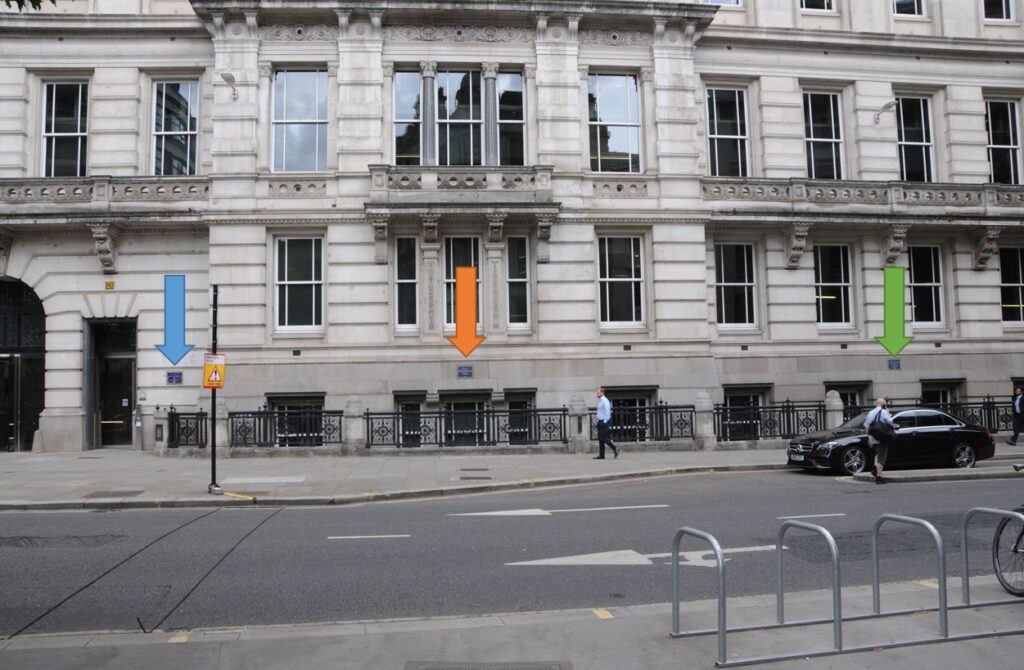
Starting from the left, and the blue arrow is pointing to:
Bull and Mouth Inn
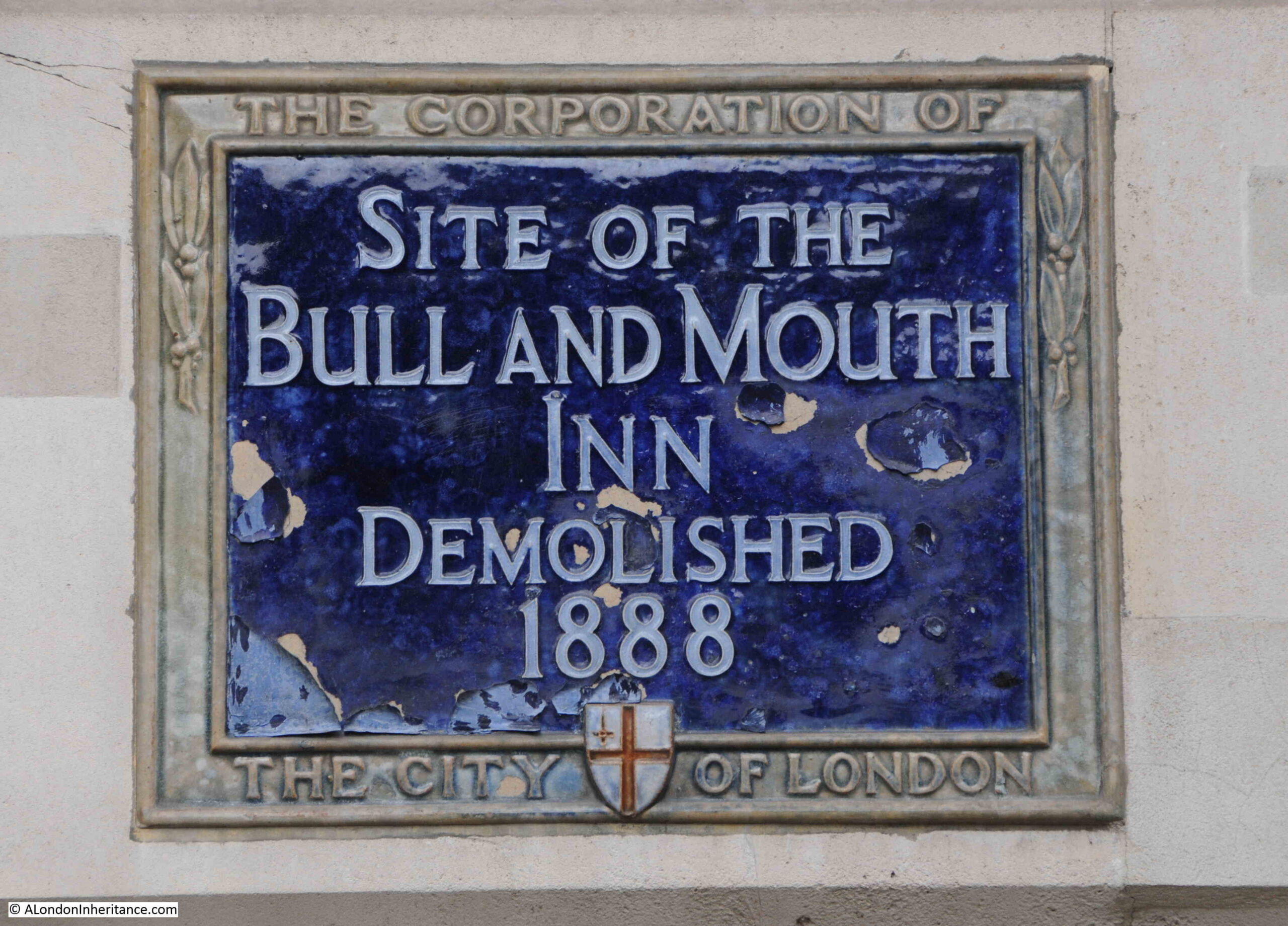
The Bull and Mouth Inn was an old coaching inn located in a side road off St Martin’s-le-Grand / Aldersgate Street. This side road had the same name as the inn – Bull and Mouth Street.
The Bull and Mouth was an old inn, and can be found in William Morgan’s 1682 map of London. In the following extract from the map, the inn is numbered 407 (circled red), and the large courtyard can be seen, surrounded by the buildings of the inn, and with a narrow entrance on to Bull and Mouth Street.
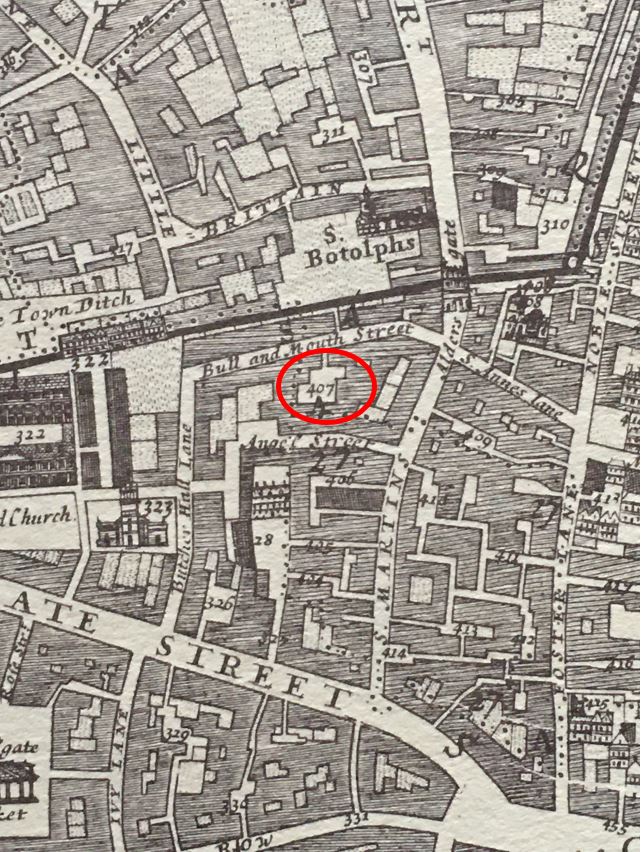
The name is unusual, and appears not to have been the original name. An article about the inn in the London Mercury on the 15th April 1848 records that the 16th century historian and antiquarian John Stowe referred to the inn as of “great antiquity”, and that the current name was a corruption of the original name of Boulogne Mouth or harbour)
The Bull and Mouth was a very busy coaching inn, with regular coach services to the north of the country. The inn was mentioned in the 1909 book “Inns, Ales and Drinking Customs of Old England” by Frederick Hackwood:
“Where could have been found a finer or more typical specimen of the old coaching-house than the Bull and Mouth in Aldersgate Street?
The scene presented by a coach-yard in full activity was always an animated and interesting one. The coach, a handsome, well-built vehicle, in all the brilliancy of a highly varnished claret ground, or it may be of a bright yellow, when ready, would stand well in the middle of the drive. the four beautiful, spirited animals attached to it, with their glossy, velvety skins, covered with cloths till the moment of ‘putting to’, would be under the charge of two stablemen in corduroy breeches and heavy boots.
Then the coachman, mounted on the box, getting his whip and his ribbons adjusted exactly to his mind. He is well buttoned up to the throat in an enormous box-coat of whitish drab colour, fastened with immense mother of pearl buttons. There is a rakish brim to his hat, which goes well with the air of nonchalance he affects – for is he not the skipper as it were, not only in command of the gallant equipage, but controlling, for the time at least, the destiny of all his passengers.”
Probably a bit of a romantic description of a lost method of travel, however it must have been an impressive sight, a coach being readied for departure, and the travelers heading across the country from the yard of the Bull and Mouth.
And coaches from the Bull and Mouth really did travel some distance.
The first mention I could find of the Bull and Mouth, was from the Derby Mercury on the 27th December 1733 where George Paschall was advertising that his wagon made a regular journey between Derby and London, leaving the Red Lyon in Derby every Saturday, reaching the Bull and Mouth on the following Saturday, from where it would depart on the Monday, arriving on either the following Friday or Saturday.
The wagon was probably for carrying goods rather than people, and the journey time between Derby and London was around five / six days.
The Bull and Mouth must have been incredibly busy. The Bull and Mouth listed the coaches and wagons departing from the inn in the Public Ledger and Advertiser on the 27th April, 1824.
The following table shows the destinations of Royal Mail coaches departing every evening from the Bull and Mouth (these were the ultimate destinations, each of these was an individual route that had plenty of intermediate stops):
The same listing also included the destinations of coaches that were not part of the Royal Mail network, along with passenger carrying wagons, again, plenty of intermediate stops before these destinations were reached:
It must have been remarkable to watch the immense amount of activity at the Bull and Mouth with the number of coaches, wagons, passengers and goods for transport, arriving or departing from the inn.
Some of these journey’s must have been incredibly arduous if you were heading to the end point of the coach’s route. I mapped out the stops of the Bull and Mouth to Glasgow coach in the following map (© OpenStreetMap contributors):
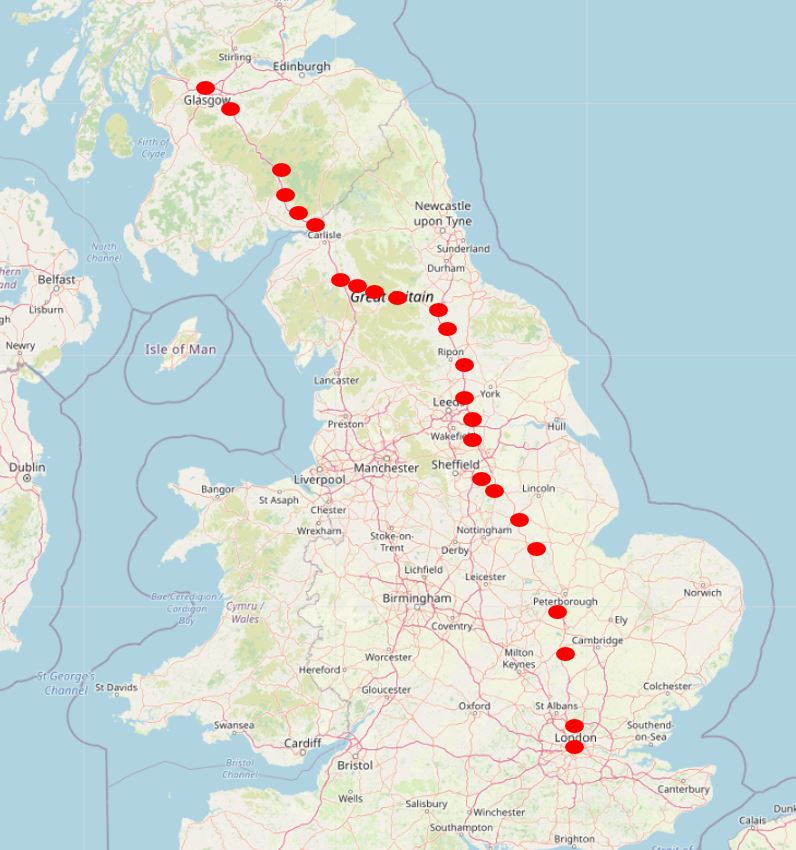
Starting at the Bull and Mouth Inn, the stops to Glasgow were then: Barnet, St. Neots, Buckden, Stilton, Grantham, Newark, Ollerton, Worksop, Doncaster, Ferrybridge, Wetherby, Boroughbridge, Leeming Lane, Catterick Bridge, Bowes, Brough, Appleby, Penrith, Carlisle, Longtown, Lockerby, Moffat, Hamilton, and finally arriving at the Pontine Inn, Glasgow.
The coach to Glasgow departed London in the evening, and arrived in Glasgow on the second morning after departure, so a total of around 36 hours, plus or minus, depending on the exact time of departure and arrival.
A long running project has been to list and map out the routes from London’s many coaching inns as they provided the city with a very comprehensive network of routes connecting London with the rest of the country. In many ways, the network of destinations and stops seems more comprehensive than the current rail network, although coach services were not as frequent, had far less capacity, and took far longer to complete than a journey by train.
A view of the inner yard of the Bull and Mouth inn dated 1810, showing the galleried interior of the inn with the rooms available for a stay, running around the galleries. A loaded wagon on the left, and barrels and boxes on the right, possibly ready for collection, or for their transport across the country (© The Trustees of the British Museum).
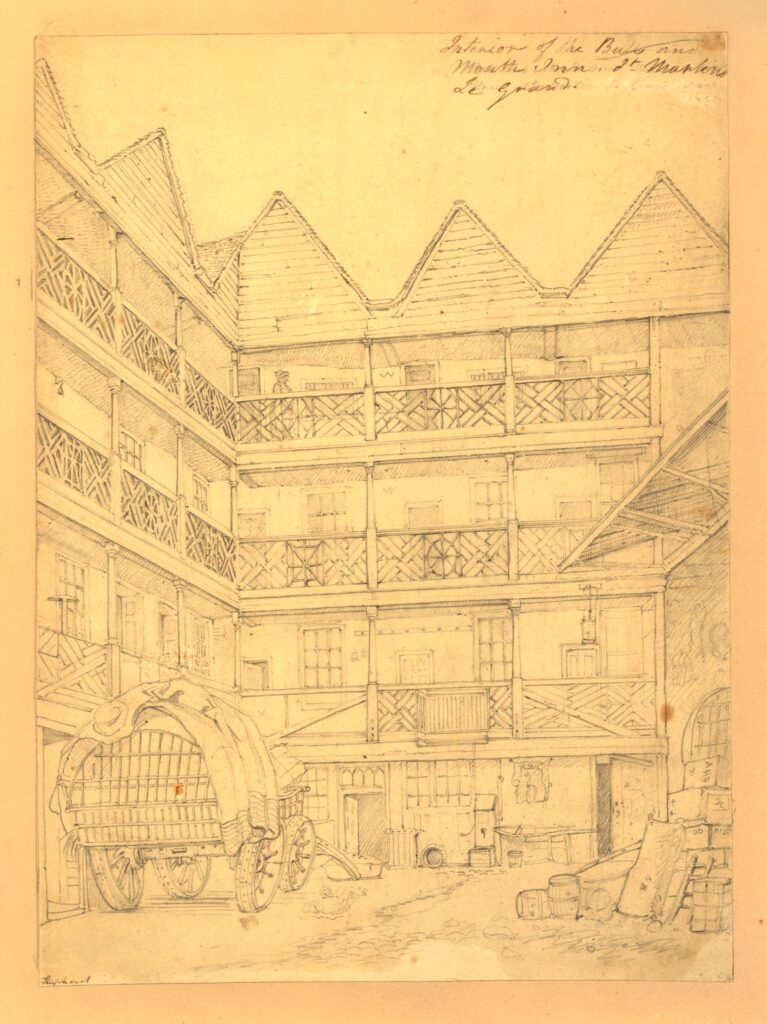
The following print, dated 1829, is titled “The Post Office, St Paul’s Cathedral and Bull and Mouth Inn”. The view must be along St Martin’s le Grand, so I assume there must have been an entrance to the inn from this street, as well as the street named after the inn. This entrance can be seen on the right where there is an archway entrance through the buildings, with some sculpture on the upper floors of the building (© The Trustees of the British Museum):
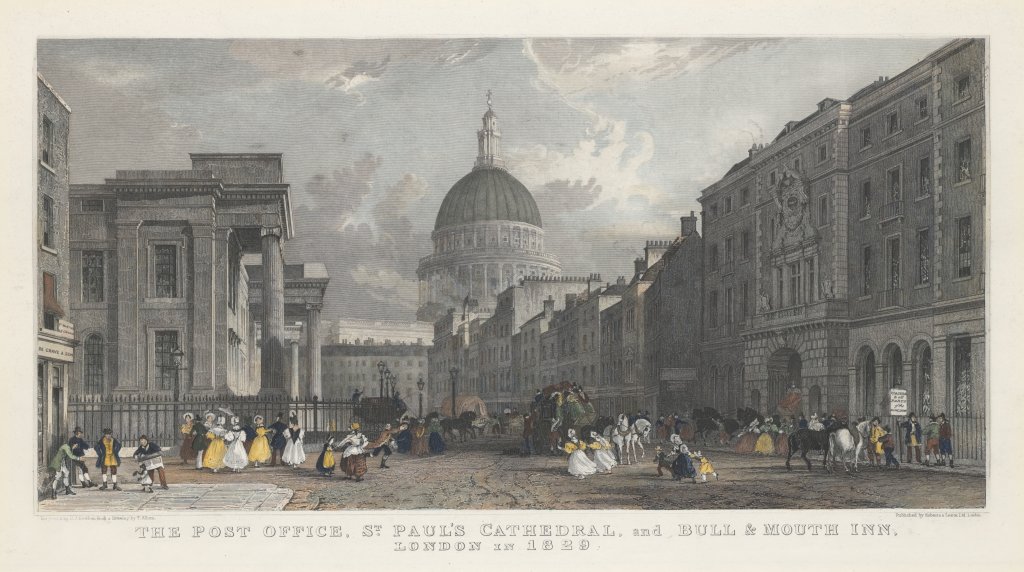
A sign from the Bull and Mouth inn can be found in the garden of the Museum of London:
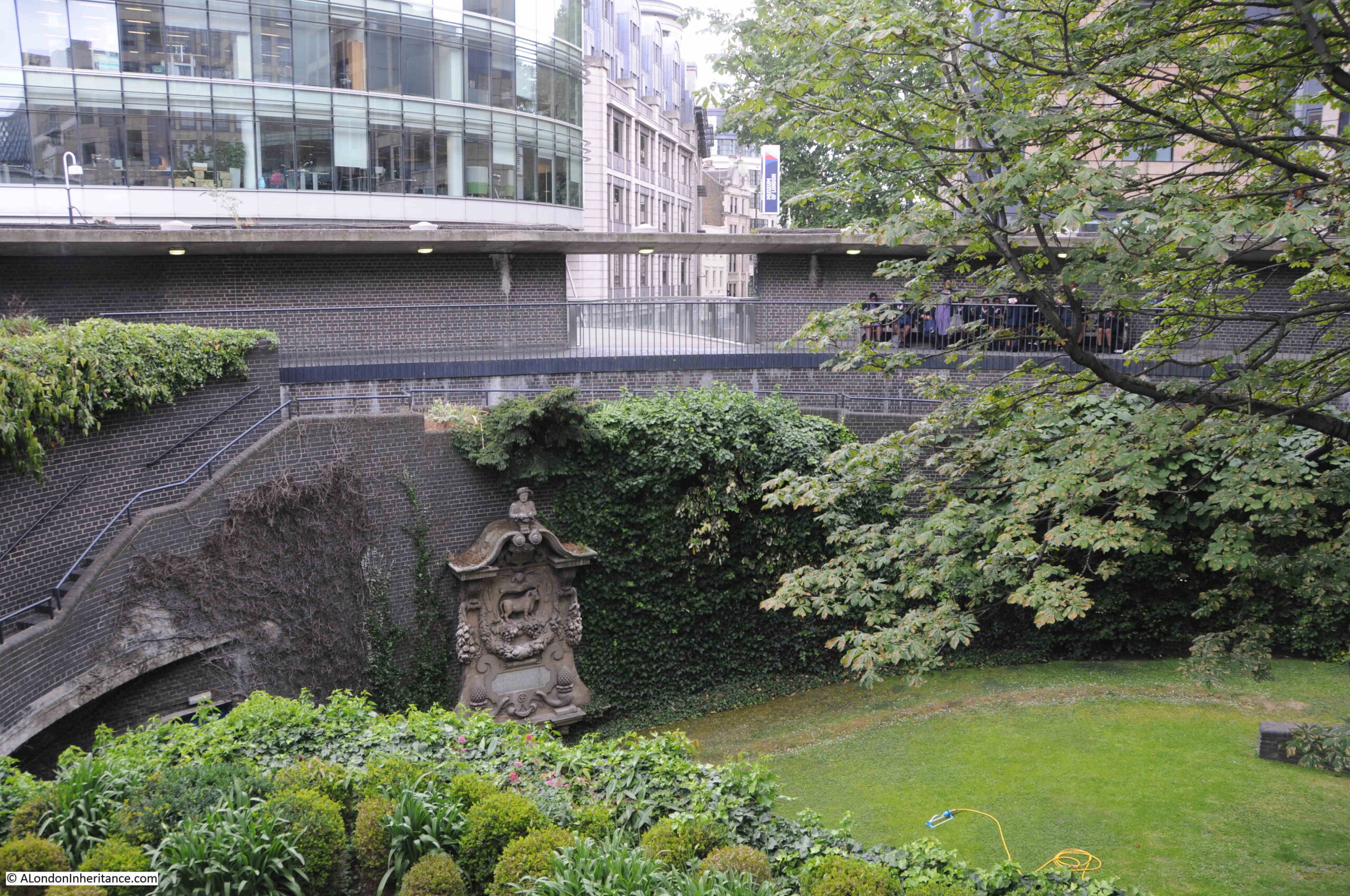
According to Henry Harben’s Dictionary of London, the Bull and Mouth Inn was destroyed in the 1666 Great Fire, was rebuilt, and then rebuilt again in 1830 as the Queen’s Hotel.
The London Mercury confirms this change and in an issue dated the 15th of April, 1848 comments that: “The Bull and Mouth had been a coaching inn ever since coaches had an existence”, and that it was the “largest and most generally recognised inn in London”. The article also alludes to the demise of the Bull and Mouth, in that when the inn was rebuilt around 1830 the railways were not yet in existence, but beginning to be talked about, and if the railways had not spread quickly across the country “the magnificent Queen’s Hotel would not have arisen on the site of the old coach-house”.
It is difficult to know the date of the Bull and Mouth sign in the Museum of London garden. The very good condition of the sign probably indicates that it was from the 1830 rebuilding of the inn.
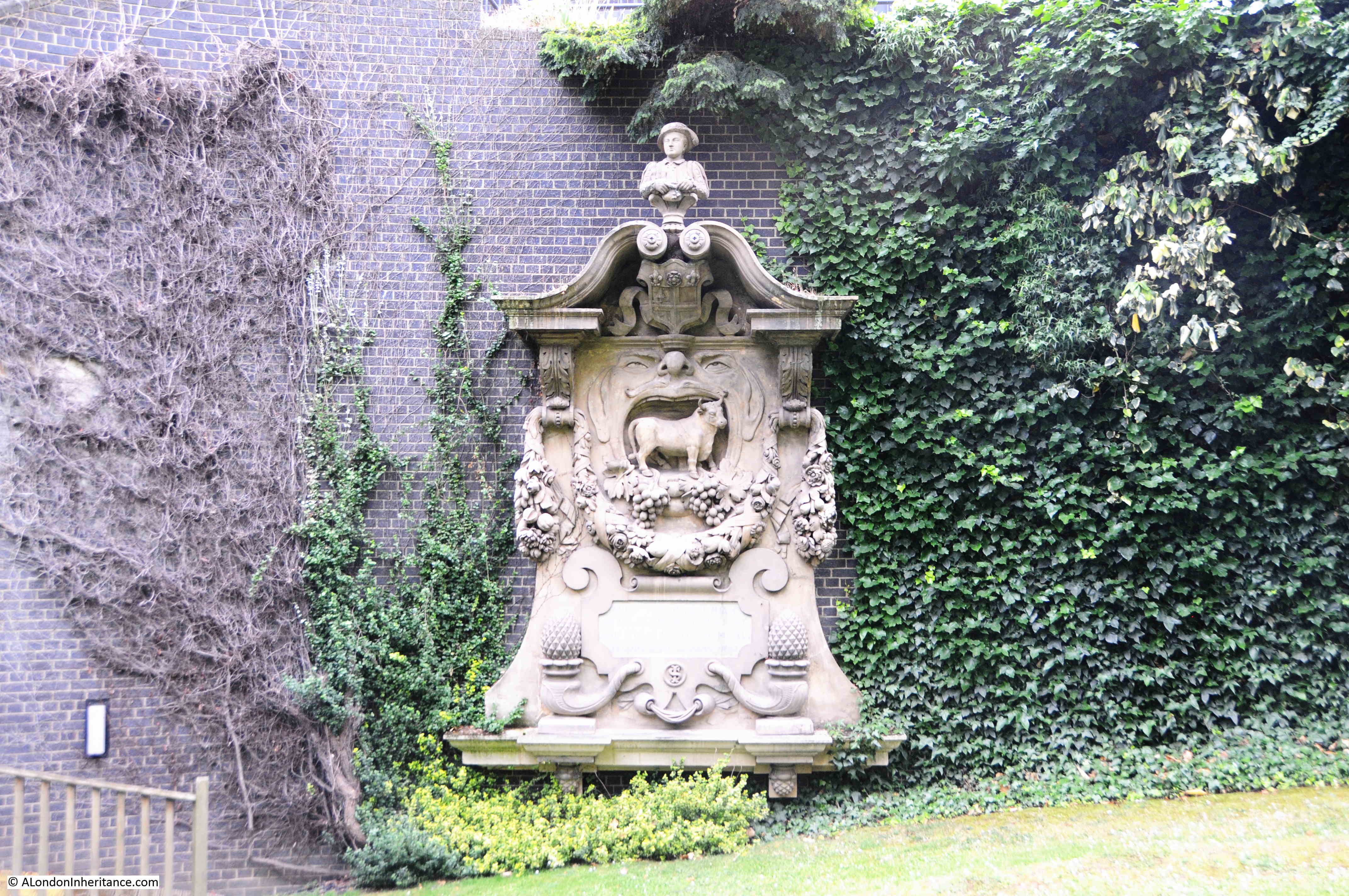
The core of the sign is a perfect visual representation of the name of the inn:
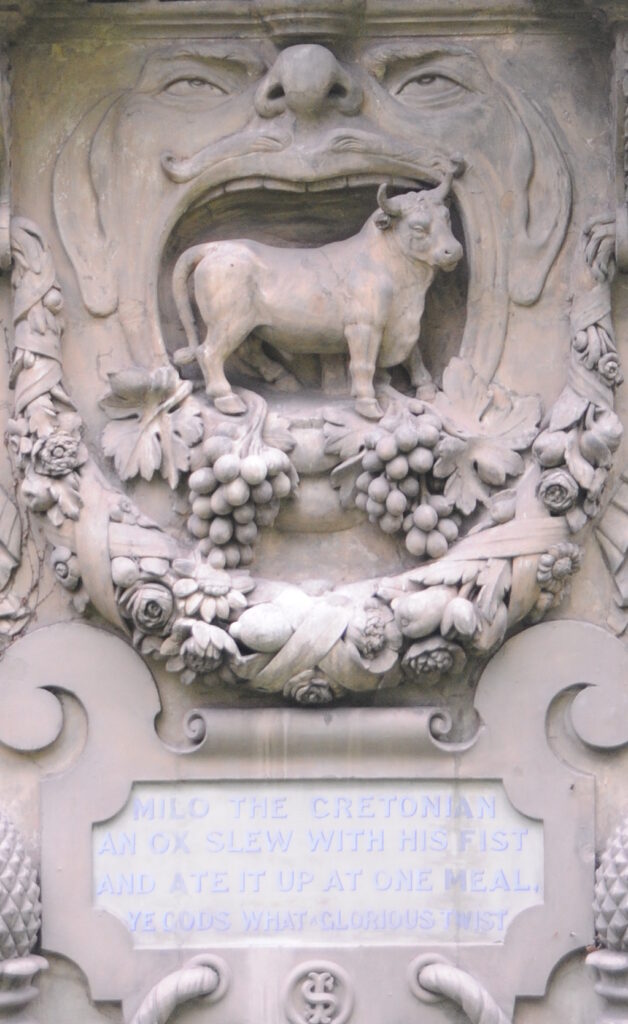
Leaving the Bull and Mouth, we now come to the middle of the three plaques, highlighted by the orange arrow, for:
Northumberland House
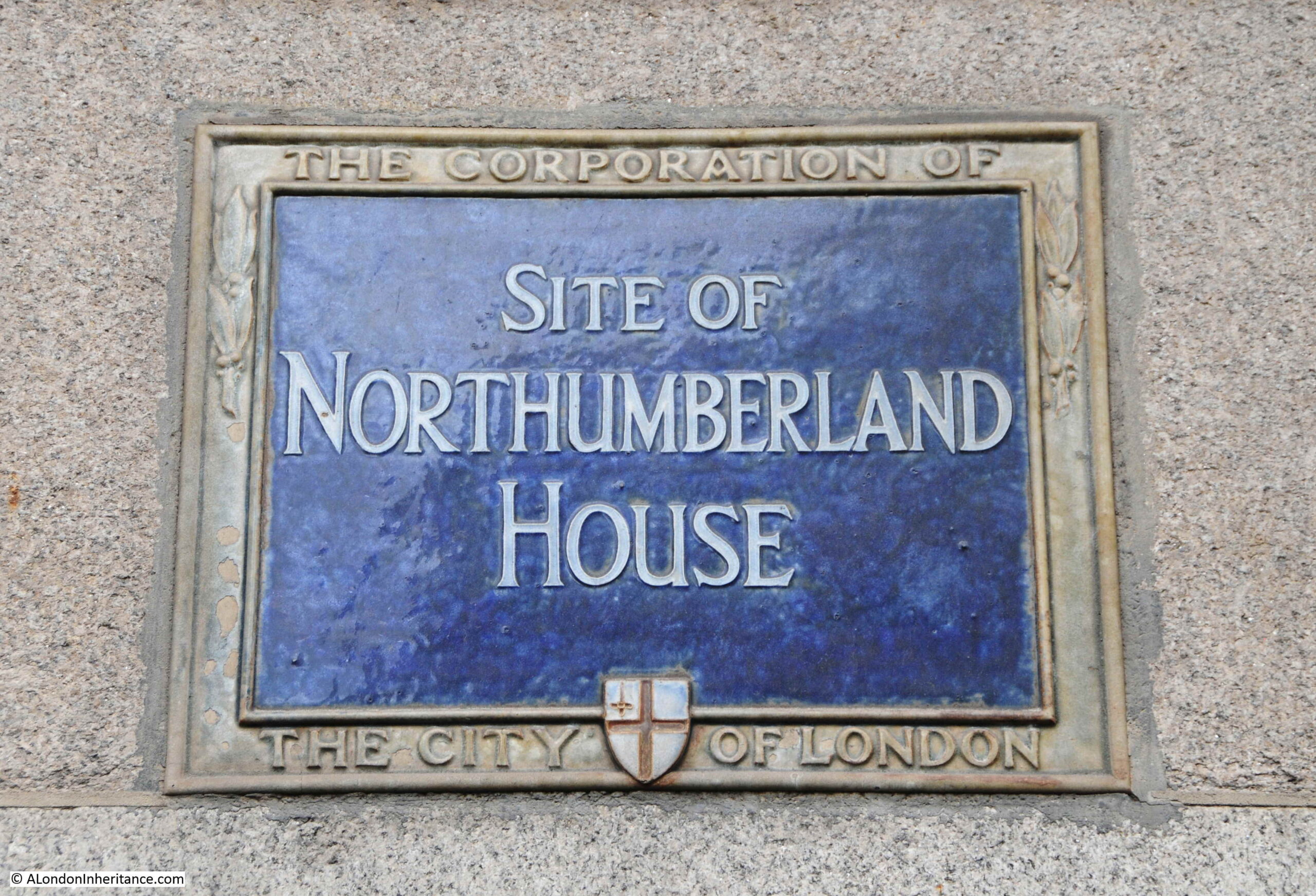
There seems very little to be found about Northumberland House. The only reference I could find was in Henry Harben’s A Dictionary of London, which states:
“Northumberland House, on the west side of St Martin’s Lane, now St Martin le Grand, in the parish of St Anne and St Agnes, in Aldersgate Ward.
It is described as a messuage, shop and garden belonging to the Earl of Northumberland, granted to Queen Joanna by Henry IV, by name of the Hostel of the Earl of Northumberland.
Stow says it was called the Queen’s Wardrobe, but now a printing house.”
A messuage was the term used to describe the collection of a residential house, outbuildings and garden.
Queen Joanna was Joan of Navarre, whose second marriage was to Henry IV in February 1403.
The Northumberland House plaque typifies one of the problems with these plaques. As a plaque it is almost meaningless. There is no context, no dates or anything to suggest why Northumberland House should have a plaque.
Information on Northumberland House is hard to find, and for the casual walker of London’s streets the plaque would get a quick glance before being forgotten. A reference to Queen Joanna, and the fact that the house must have been 15th century would at least add some background as to why the plaque is there.
The final plaque on the wall of three is the one on the right with the green arrow, and is for the:
French Protestant Church
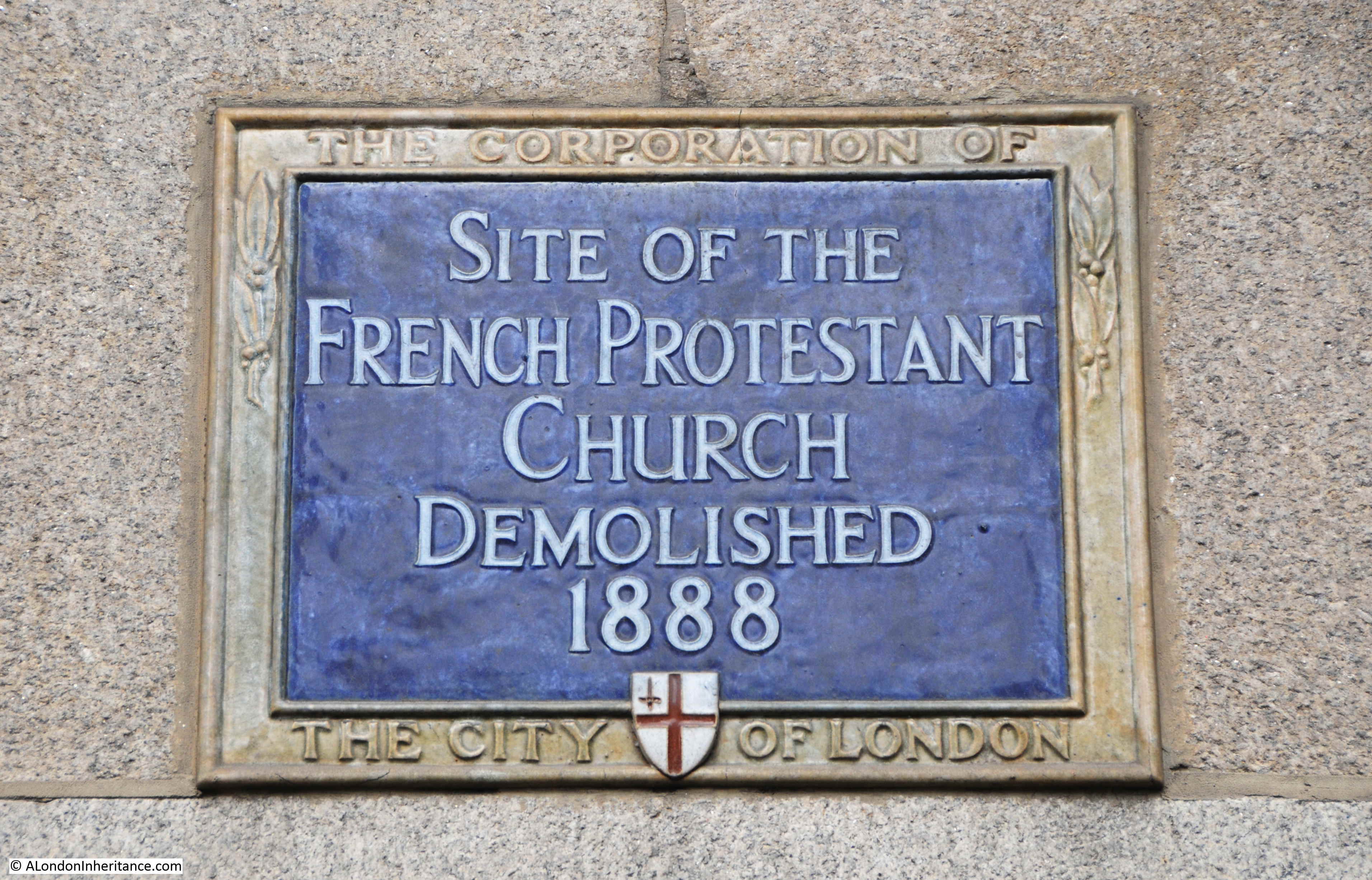
An article in the Illustrated London News in 1848 provides background information on the French Protestant Church, and a good description of St Martin’s le Grand at the time:
“Another new church for London! – just now finished, and about to be opened. The site chosen is one which has felt the full benefit of modern improvements. Not many years ago St Martin’s le Grand had little to recommend it to the eye – now it is surrounded by fine buildings, and forms one of the choicest openings in the tortuous monotony of London bricks and mortar.
We have here one of our best Grecian buildings, the Post-Office, next to the Hall of the rich Goldsmiths; then that most magnificent of caranserais with the most un-euphonious of titles – the Bull and Mouth; and last and least, the small, but picturesque chapel of the French protestants.
The French Protestants original church was in Threadneedle Street; their church being an old structure, with few architectural pretensions. This having been demolished, they have removed their place of worship to St Martin-le-Grand.
The architect, Mr. Owen, has succeeded in completing a very perfect, though small, pointed Gothic chapel. The interior, with its lancet windows, tall roof, and appropriate pulpit, is well managed, considering the confined space the artist had to work in. The cost has been £5,000 and the public will soon have the opportunity of judging how wisely it has been expended, as the church will shortly be opened for divine service.”
Although the church was demolished, we can still have the “opportunity of judging how wisely it has been expended“, by looking at the following photo of the French Protestant Church:
Source: Unknown author, Public domain, via Wikimedia Commons
I cannot confirm the date of the above photo, however given the church was only about 40 years old when it was demolished, it does give the impression of being much older. Probably the Gothic design, along with the level of dirt on the building from the smoky atmosphere of London.
The church was demolished by 1888, and newspaper articles in June 1887 reported on the closure of the church “The last service has been held in the French Protestant Church in St Martin’s-le-Grand and the singularly beautiful and interesting little church is doomed to prompt destruction in order to make way for an extension of the General Post-office.”
The origins of the French Protestant Church date back to 1550, when Edward VI signed the charter granting freedom of worship to Protestants from France, Wallonia, and the Netherlands.
The majority of Protestant immigrants from continental Europe came after 1661, when the Edict of Nantes (which had protected the Protestant faith in France) was dismantled by Louis XIV. In the following years around 50,000 Huguenots fled to England, and a number of churches were set-up specifically for the new arrivals.
After the St Martin’s-le-Grand church was demolished, the church received £26,000 of compensation which enabled a site in Soho to be purchased (an area which had at the time the greatest concentration of French protestants), and the current French Protestant Church of London on Soho Square was built.
That’s a brief overview of the three plaques on the western side of the street. Directly opposite is another plaque, which can be seen on the side of the Lord Raglan pub:
Aldersgate
The plaque records that one of the original gates in the City wall was on the site and was demolished in 1761:
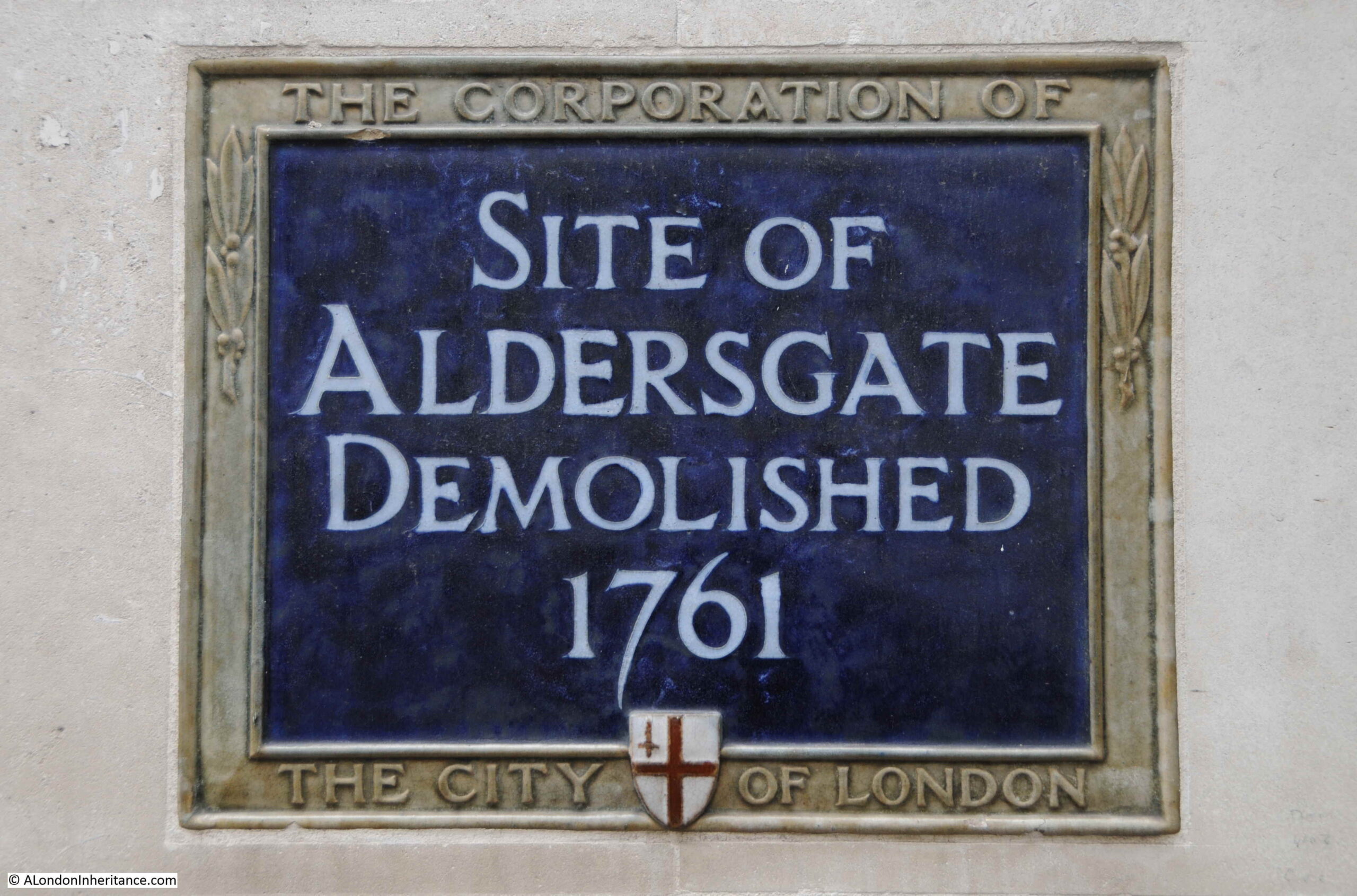
Aldersgate was one of the principal gates through the City wall, and can be seen in the same extract from Morgan’s map that I used for the Bull and Mouth inn (circled in red):
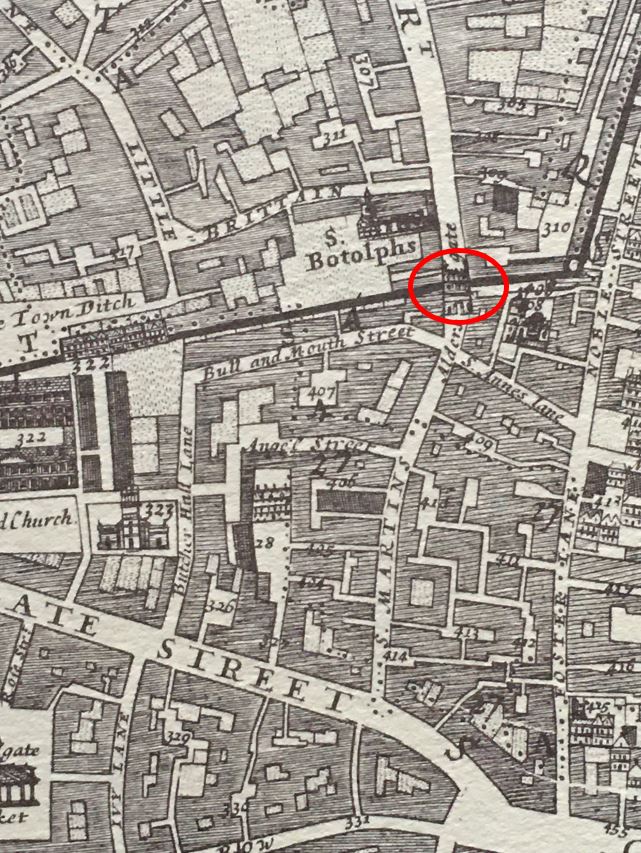
The name appears to derive from the name of an individual, either Ealdred or Aldred, however the problem with being sure of the source of a name for something as old as the gate is that there have been many different variations, and no written records that confirm the original source.
Harben’s Dictionary of London lists a number of variants to the name, and states there were sixty-two variations of the name to be found in documents between 1274 and 1597.
A view of Aldersgate can be seen at bottom left in the follow print showing the gates of the City from William Maitland’s 1756 History of London (© The Trustees of the British Museum):
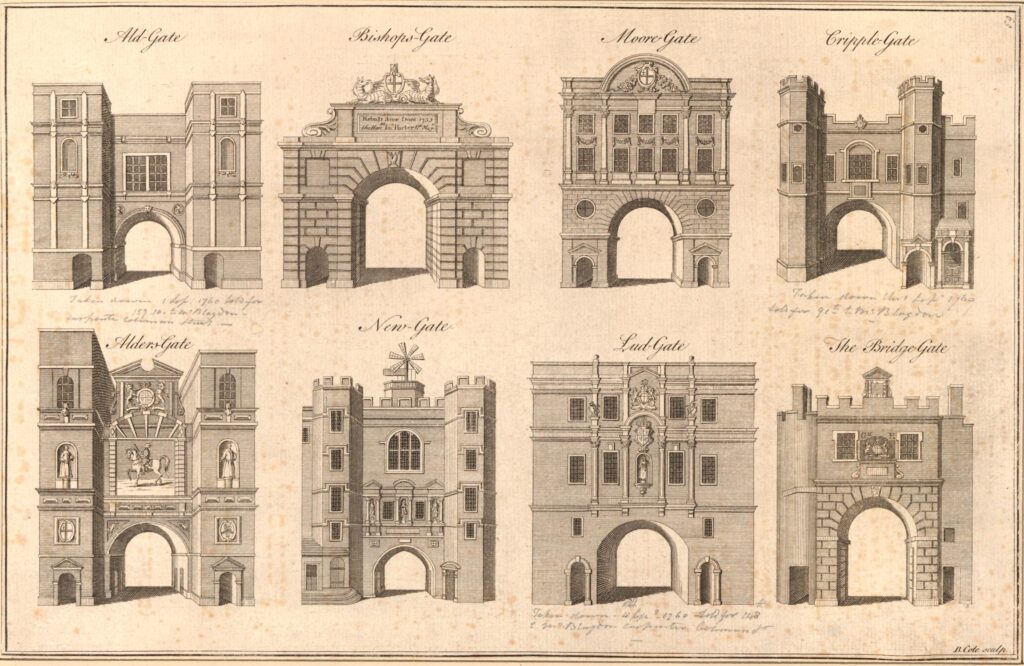
Harben lists some dates when there were changes to the gate:
- 1335 – it was ordained that the gate should be covered with lead and a small house made under it for the gate-keeper
- 1617 – The gate was taken down and rebuilt
- 1670 – Repaired and beautified after the 1666 Great Fire
- 1739 – Repaired again by the Lord Mayor
- 1750 – The apartments over the gate were occupied by the Common Crier
The gate was finally demolished in 1761, with the materials sold for £91.
By the later years of the 18th century, the City gates were an obstruction for the traffic that moved through the gate. With the northwards expansion of the City, the gate had long lost its role as a protective gateway into the City, so it made sense to demolish and open up the road for the growing numbers of people and horse drawn traffic travelling along the City streets.
A final look down St Martin’s-le-Grand. Aldersgate would have been just in front of me. The Lord Raglan pub with the Aldersgate plaque is on the left, and the other three plaques are along the building on the right.
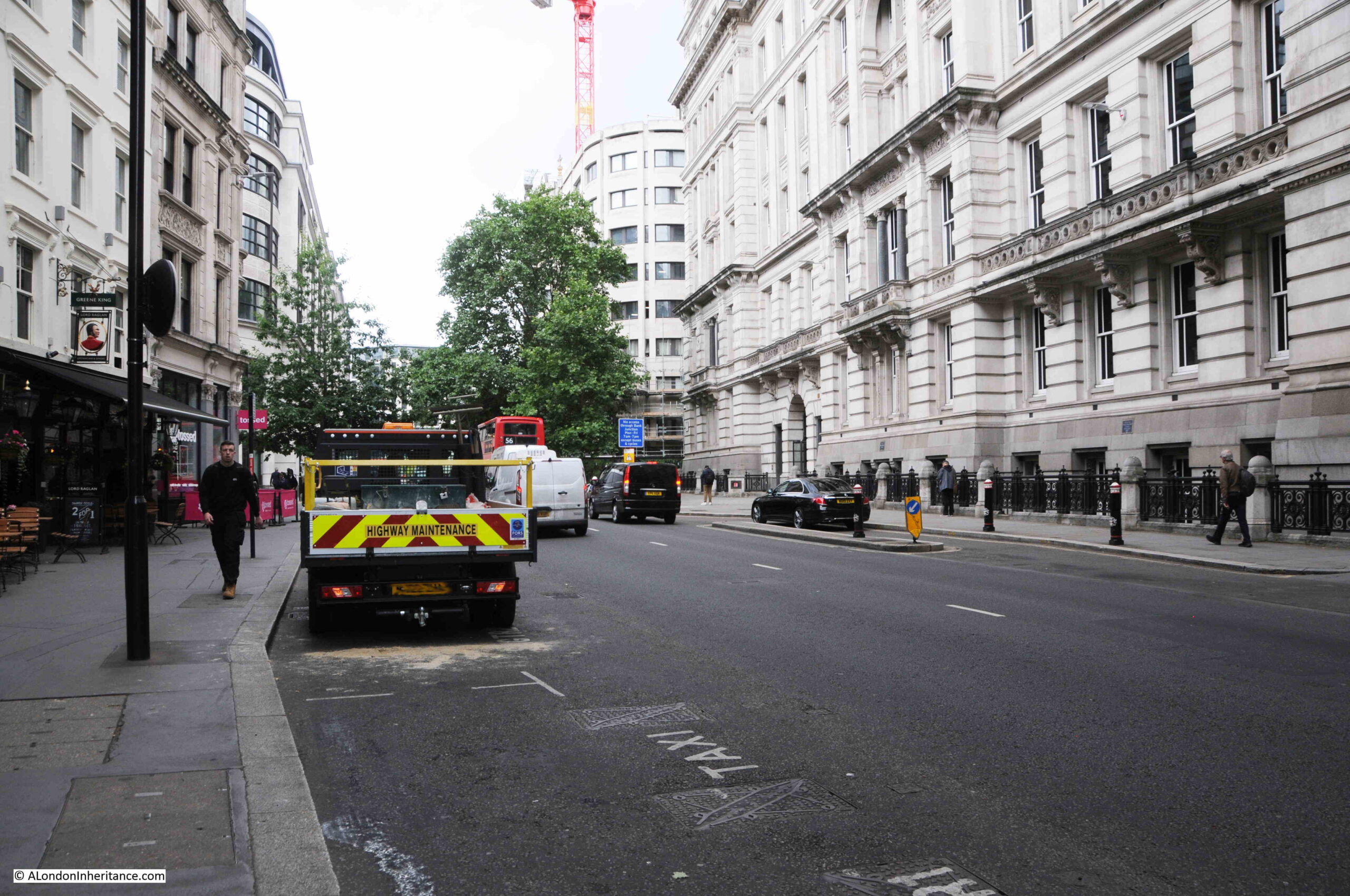
The photo was taken from the point where St Martin’s-le-Grand (in the photo) changes into Aldersgate Street (behind me).
That is four more City of London plaques recording the diverse range of buildings and structures that have been lost from the City’s streets.
There will at some point, be an interactive map of the plaques, along with a spreadsheet to download listing all sites and details of each plaque.

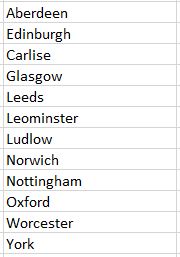
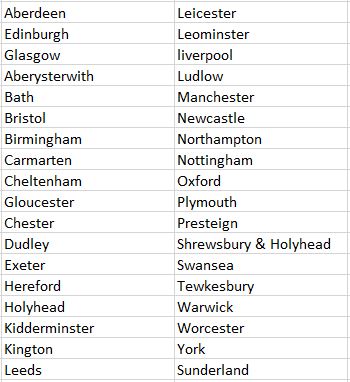
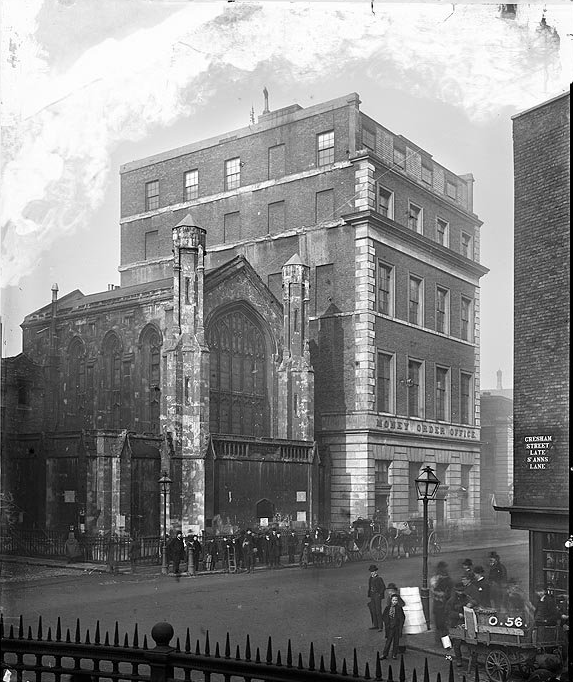
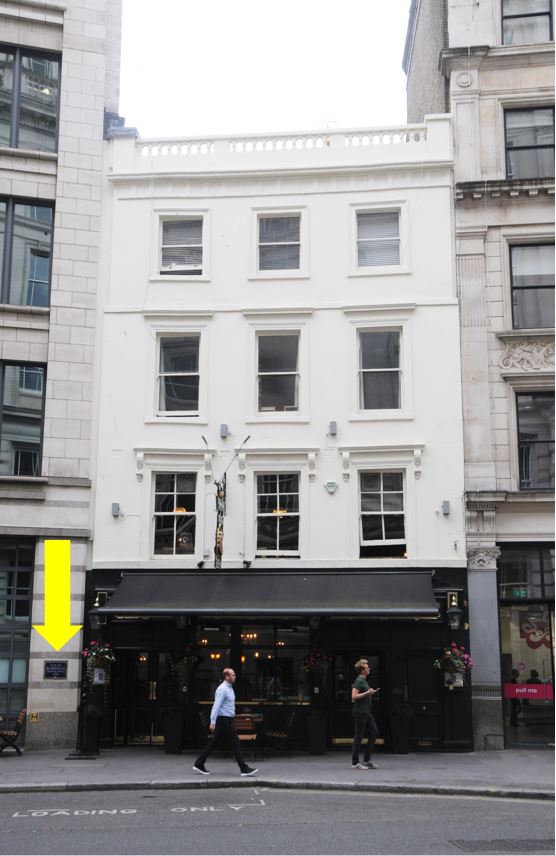
The name of the Bull and Mouth is a strange one, said to be corrupted from the ‘Boulogne Mouth’ commemorating Henry VIII’s capture of that port in 1544. Rented rooms at the Bull and Mouth became London’s first and main Quaker meeting-house, or ‘threshing-floor’ between 1654 and 1666. It was the site of intense persecution, with frequent violent mass arrests in the 1660s: Richard Baxter wrote in his Reliquiæ Baxterianæ that here at the Bull and Mouth ‘the fanatics called Quakers did greatly relieve the sober people for a time; for they were so resolute, and gloried in their constancy and sufferings, that they assembled openly and were dragged away daily to the common jail; and yet desisted not, but the rest came the next day nevertheless. So that the jail at Newgate was filled with them.’ The Bull and Mouth burned down in the Great Fire of 1666, and the Quakers moved to Devonshire House in Bishopsgate. The B&M was probably the most famous centre of dissent in the City and William Winstanley ostensibly calculated his satirical ‘Yea and Nay Almanack’ (1678), long after the fire, “for the meridian of the bull and mouth within Aldersgate. And may indifferently serve for any meeting-house either in Wales or England.”
Many thanks for another interesting events in the City of London. Living in North London during my teens and early 20’s I was unaware of our history.
I am very much looking forward to the interactive map and spreadsheet! But in the meantime, my thanks again for such a wonderful treat each Sunday morning.
I was interested to read about the Bull and Mouth. I have a Wapping Quaker distiller’s marriage there in 1696. I wonder how common this was and why the marriage took place there.
There’s a bit more here on this Northumberland House – fourth para down: https://www.british-history.ac.uk/old-new-london/vol3/pp135-141
Another splendid exposition,Thank you. The dots are being joined up by your (tireless?) efforts. Fascinating. Many many thanks.
I really enjoyed this post! Lots of interesting information, and a launching pad for further reading. Thanks so much for what you do.
Another very interesting post on a great subject. I am looking forward to the map and spreadsheet.
The Bull and Mouth later became the Queens Hotel, in St Martins le Grand. I have quite a bit more history o it on the pubwiki.
Kevan
Thank you for the excellent article. I was searching in reference to: SIMMONS (THOMAS), bookseller in London; Bull and Mouth near Aldersgate, 1656-62. Publisher of Quaker books.
I very much enjoy your deep exploration of London sites (though I often come to them rather late). They’ve provided guidance when I’m doing research for my books. But they are simply fascinating, whether or not it’s a topic I’m currently researching.
Regarding Northumberland House: It took some digging, but I did find a decent amount of information about the place, including images, which I incorporated in a blog post at the time.
https://twonerdyhistorygirls.blogspot.com/2011/07/northumberland-house-last-mansion-in.html